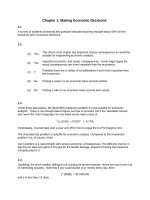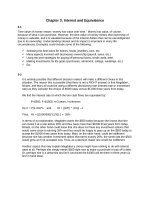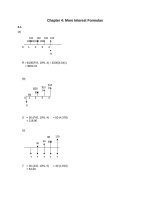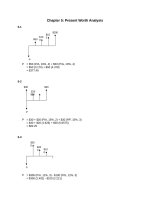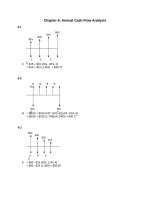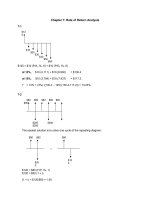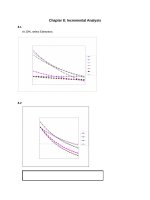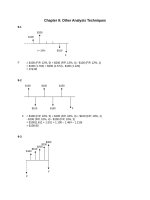Solution manual engineering economic analysis 9th edition ch03
Bạn đang xem bản rút gọn của tài liệu. Xem và tải ngay bản đầy đủ của tài liệu tại đây (50.66 KB, 6 trang )
Chapter 3: Interest and Equivalence
3-1
Time value of money means ‘money has value over time.’ Money has value, of course,
because of what it can purchase. However, the time value of money means that ownership of
money is valuable, and it is valuable because of the interest dollars that can be earned/gained
due to its ownership. Understanding interest and its impact is important in many life
circumstances. Examples could include some of the following:
Selecting the best loans for homes, boats, jewellery, cars, etc.
Many aspects involved with businesses ownership (payroll, taxes, etc.)
Using the best strategies for paying off personal loans, credit cards, debt
Making investments for life goals (purchases, retirement, college, weddings, etc.)
Etc.
3-2
It is entirely possible that different decision makers will make a different choice in this
situation. The reason this is possible (that there is not a RIGHT answer) is that Magdalen,
Miriam, and Mary all could be using a different discounting rate (interest rate or investment
rate) as they consider the choice of $500 today versus $1,000 three years from today.
We find the interest rate at which the two cash flows are equivalent by:
P=$500, F=$1000, n=3 years, i=unknown
So, F = P(1+i%)^n
and,
i% = {(F/P) ^ (1/n)} –1
Thus, i% = {(1000/500)^(1/3)}-1 = 26%
In terms of an explanation, Magdalen wants the $500 today because she knows that she
can invest it at a rate above 26% and thus have more than $1000 three years from today.
Miriam, on the other hand could know that she does not have any investment options that
would come close to earning 26% and thus would be happy to pass up on the $500 today to
accept the $1000 three years from today. Mary, on the other hand, could be indifferent
because she has another investment option that earns exactly 26%, the same rate the $500
would grow at if not accepted now. Thus, as a decision maker she would be indifferent.
Another aspect that may explain Magdalen’s choice might have nothing to do with interest
rates at all. Perhaps she simply needs $500 right now to make a purchase or pay off a debt.
Or, perhaps she is a pessimist and isn’t convinced the $1000 will be there in three years (a
bird in hand idea).
3-3
$2,000 + $2,000 (0.10 x 3) = $2,600
3-4
($5,350 - $5,000)
/(0.08 x $5,000) = $350/$400 = 0.875 years= 10.5 months
3-5
$200
4
Q
Q = $200 (P/F, 10%, 4)
= $200 (0.683)
= $136.60
3-6
P = $1,400 (P/A, 10%, 5) - $80 (P/G, 10%, 5)
= $1,400 (3.791) - $80 (6.862)
= $4,758.44
Using single payment factors:
P
= $1400 (P/F, 10%, 1) + $1,320 (P/F, 10%, 2) + $1,240 (P/F, 10%, 3) +
(P/F, 10%, 4) + $1,080 (P/F, 10%, 5)
= $1,272.74 + $1,090.85 + $931.61 + $792.28 + $670.57
= $4,758.05
3-7
P=$750, n =3 years, i =8%, F =?
F
= P (1+ i)n = $750 (1.08)3
= $945
= $750 (1.260)
Using interest tables:
F
= $750 (F/P, 8%, 3)
= $945
= $750 (1.360)
$1,160
3-8
F =$8,250, n = 4 semi-annual periods, i =4%, P =?
P = F (1+i)-n
= $7,052.10
= $8,250 (1.04)-4
= $8,250 (0.8548)
Using interest tables:
P = F (P/F, 4%, 4)
= $7,052.10
= $8,250 (0.8548)
3-9
Local Bank
F = $3,000 (F/P, 5%, 2) = $3,000 (1.102)
= $3,306
Out of Town Bank
F = $3,000 (F/P, 1.25%, 8) = $3,000 (1.104)
= $3,312
Additional Interest = $6
3-10
P = $1
n = unknown number of
semiannual periods
F
= P (1 + i)n
2
= 1 (1.02)n
2
= 1.02n
n
= log (2) / log (1.02)
= 35
i = 2%
Therefore, the money will double in 17.5 years.
3-11
Lump Sum Payment
= $350 (F/P, 1.5%, 8) = $350 (1.126)
= $394.10
Alternate Payment
= $350 (F/P, 10%, 1) = $350 (1.100)
= $385.00
Choose the alternate payment plan.
F=2
3-12
Repayment at 4 ½%
= $1 billion (F/P, 4 ½%, 30)
= $1 billion (3.745)
= $3.745 billion
= $1 billion (1 + 0.0525)30
= $4.62 billion
Repayment at 5 ¼%
Saving to foreign country = $897 million
3-13
Calculator Solution
1% per month F
12% per year
= $1,000 (1 + 0.01)12 = $1,126.83
F
= $1,000 (1 + 0.12)1
Savings in interest
= $1,120.00
= $6.83
Compound interest table solution
1% per month F
= $1,000 (1.127)
= $1,127.00
12% per year
F
= $1,000 (1.120)
= $1,120.00
Savings in interest
= $7.00
3-14
Q6
Q10
i = 5%
P = $60
Either:
Q10
Q10
= Q6 (F/P, 5%, 4)
= P (F/P, 5%, 10)
(1)
(2)
Since P is between and Q6 is not, solve Equation (2),
Q10
= $60 (1.629)
= $97.74
3-15
P = $600
F = $29,152,000
n = 92 years
F
= P (1 + i)n
$29,152,000/$600 = (1 + i)92
(1 + i)
i*
= ($48,587)(1/92)
= $45,587
= $48,587
= 0.124 = 12.4%
3-16
(a) Interest Rates
(i)
Interest rate for the past year = ($100 - $90)/$90
= $10/$90
= 0.111 or 11.1%
(ii)
Interest rate for the next year = ($110 - $100)/$100
= 0.10 or 10%
(b) $90 (F/P, i%, 2) = $110
(F/P, i%, 2) = $110/$90= 1.222
So,
(1 + i)2 = 1.222
i
= 1.1054 – 1 = 0.1054
= 10.54%
3-17
n = 63 years
i = 7.9%
F = $175,000
P = F (1 + i)-n
= $175,000 (1.079)-63
= $1,454
3-18
F
= P (1 + i)n
Solve for P:
P
= F/(1 + i)n
P
= F (1 + i)-n
P = $150,000 (1 + 0.10)-5 = $150,000 (0.6209)
= $93,135
3-19
The garbage company sends out bills only six times a year. Each time they collect one
month’s bills one month early.
100,000 customers x $6.00 x 1% per month x 6 times/yr
= $36,000
3-20
Year
0
1
2
3
4
Cash Flow
-$2,000
-$4,000
-$3,625
-$3,250
-$2,875
